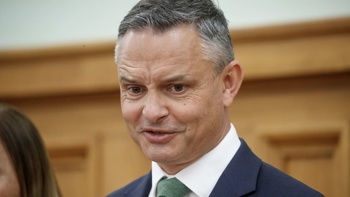There are 6133 new community Covid cases today, with the country's top doctor saying the decreasing trend is "encouraging" - but still above what modelling had predicted.
The Ministry of Health reported a further 23 Covid-related deaths.
They include one person from Northland, five from the Auckland region, three from Waikato, one from the Lakes DHB region, four from Taranaki, two from MidCentral, one from Hawke's Bay; two from the Wellington region; one from South Canterbury and three from Southern.
One person was aged in their 50s; three were in their 70s; 11 were in their 80s; and eight were aged over 90. Of these people, 15 were women and eight were men.
Today's reported deaths take the total number of publicly reported deaths with Covid-19 to 1348.
There are 377 people in hospital with the virus, including seven in intensive care, the ministry said in today's update.
The seven-day rolling average of community case numbers today is 5983 – last Tuesday it was 6202.
Today's community cases are in Northland (191), Auckland (1,800), Waikato (406), Bay of Plenty (240), Lakes (90), Hawke's Bay (186), MidCentral (233), Whanganui (72), Taranaki (179), Tairāwhiti (42), Wairarapa (77), Capital and Coast (510), Hutt Valley (261), Nelson Marlborough (243), Canterbury (904), South Canterbury (92), Southern (541 551), West Coast (54), unknown (2).
'Encouraging' decrease in case numbers: Bloomfield
Director general of health Dr Ashley Bloomfield told reporters that the number of new infections and deaths is declining internationally. This indicated that the drop in case numbers was real.
Case numbers were "encouraging" but the 6000 daily numbers was still double what officials had modelled.
He estimated that community testing was identifying about two-thirds of infections in this country. Cases were increasing in those aged over 65, who were more likely to be hospitalised or to die from the virus.
The rollout of a fourth Covid vaccine for those most at risk would begin shortly, he said.
Masks remained an important tool to stay safe from both Covid and winter influenza.
Staying at home if you were unwell was also "fundamental", he said.
Today is the first time Bloomfield has fronted a press conference since he contracted the virus just over two weeks ago while attending the World Health Assembly in Geneva, Switzerland.
Review into PCR testing backlog
A review, commissioned by the Ministry of Health and released today, has found that a backlog in PCR testing in February should have been predicted.
The ministry's model testing forecast that single test capacity would be exceeded, and modelled scenarios that forecasted PCR testing capacity with pooling, would also be exceeded.
"However, there were deficiencies in the Covid-19 testing system design and operational management that meant that testing strategy objectives were not met because risks to those objectives were not adequately managed or communicated," the review says.
"A disconnect emerged in the knowledge and understanding of the Covid-19 Directorate and the laboratories relative to the director-general and Ministers, which led to them being unprepared for the PCR backlog that eventuated."
The review makes a series of recommendations in order to avoid similar circumstances emerging in the future.
Bloomfield said that the rapid onset of Omicron forced the testing system to switch from PCR tests to rapid antigen testing (RATs).
This was not a smooth transition and had resulted in a backlog of 32,000 samples, mostly in Auckland. The backlog was cleared by mid-March, Bloomfield said.
The review had found that lab capacity, planning, reporting of lab capacity and aspects of internal design were the causes for the testing delays.
Moving samples across the country was a major cause for the early backlog, Bloomfield said.
"The teams have done their best at the time, but it's clear we can and should have done better."
Ministry of Health chief science adviser Dr Ian Town said that a key part of responding to the outbreak was to have a clear picture of hospitalisation of Covid-19 patients.
Preliminary data showed that when people were admitted to hospital suggested that for two-thirds of patients Covid was the primary cause reason of admission.
Those who were unvaccinated were three times more likely to end up in intensive care, Town said.
There was no doubt that hospitals were busy, which happened every winter, he said.
Yesterday, there were 4413 new cases in the community and five Covid-related deaths.
There were 352 people in hospital with the virus, including nine in intensive care.
Today, a review into the Ministry of Health's response to the Delta outbreak last August revealed that the measures in place became overwhelmed just a month after the first case was detected.
The outbreak came after no cases in the community for more than 100 days.
The review, commissioned by Bloomfield, said by mid-September cases had reached more than 1000 a day and were spreading to hard-to-reach locations.
By October, the health system was straining to meet the needs of people who became infected with Delta.
Since the beginning of the pandemic, 1325 people have died with Covid and 1,236,398 people have been infected in New Zealand.
Microbiologist Siouxsie Wiles told RNZ that it is a matter of when, and not if, the next large wave of Covid-19 cases will hit.
Wiles said that Omicron subvariants BA2.2, BA.4 and BA.5, which are all in New Zealand, are responsible for surging cases overseas and could add further pressure to the health system during winter.
"We know that the variants that are starting to cause increasing cases overseas are now here in New Zealand and so the question is at what point are we going to see the large surge in cases."
Meanwhile, hospital staff are calling for Health Minister Andrew Little to acknowledge that there is a hospital crisis.
A doctor said Middlemore Hospital has hit a "level of panic", shifting to code red as they manage an influx of patients.
In one night, 71 patients were waiting for beds in the hospital's emergency department. Another night more than 420 patients came in; normally it gets 300.
Top emergency doctor John Bonning told the Herald that hospitals across the country were seeing "record-level delays and record numbers of patients".
"Middlemore Hospital saw its biggest day ever" on Tuesday night, he said.
Bonning said it was time for Little to show leadership and he had advised him to reintroduce hospital wait-time targets.
"A patient that arrives in an emergency department with a 10 per cent access block, which means if you have 100 patients and 10 have been there for longer than eight hours, then they have a 10 per cent greater chance of dying over the next seven days," Bonning said.
"There is a very real impact for people waiting."
Little told the Herald that while hospitals were under pressure, "as they were every winter", they were coping.
The minister said he had not seen any data showing hospitals were reaching record levels of delays and patient presentations.
"It would be interesting if he [Bonning] did provide it, because he is known to say things like that without backing it up with data."
Take your Radio, Podcasts and Music with you









